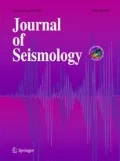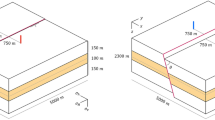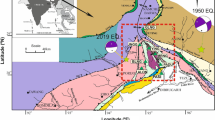Abstract
Experimental data pertaining to weak faults requires construction of microscopic models of the earthquake sources. This study proposes a new high-energy mechanism of transformation of potential energy of strata, saturated with free or bounded fluids, into a kinetic energy of motion of rocks. The proposed approach relies within the framework of classic statistical theory. The high-energy phenomena at a nanometer level are generated by self-consistent molecular fields acting on individual particles. The analysis is carried out using the Bogolyubov-Born-Green-Kirkwood-Yvon equations for the particle group distribution functions. We have investigated the number of high-energy phenomena: (1) the emission of atoms and molecules with high energies from the abruptly opened surface of a condensed system; (2) the implosion of convergent streams of high-energy particles, accompanied by a phenomena of their shock dissociation and ionization, with a subsequent formation of partially ionized plasma; and (3) the recombination processes inside a plasma leading to a formation of molecules with high kinetic energies. The initiation of an earthquake occurs due to an abrupt opening of a cavity in the fluid-saturated medium. At certain thermodynamic conditions, the work function of atoms and molecules from the surface of the system may take negative values. As a result, the emission of molecules of fluids from the cavity walls will generate the high-speed streams of molecules. The emitted flux of molecules leads to the phenomena of implosion, impact dissociation, and ionization of the molecules. This plasma state of the medium is sufficient for an explosion. The explosion initiates a self-supporting chain of consequent explosions in a plane of the tectonic fault. As an example, we have considered the Bridgman explosion of serpentinite.






Similar content being viewed by others
References
Adushkin VV, Spivak AA (1994) Geologic characterization and mechanics of underground nuclear explosions. Defense Nuclear Agency
Adushkin VV, Spivak AA (2004) Changes in properties of rock massifs due to underground nuclear explosions. Combust Explos Shock Waves 40:624–634
Andersen HC, Weeks JD, Chandler D (1971) Relationship between the hard-sphere fluid and fluids with realistic repulsive forces. Phys Rev A 4:1597–1607
Aslanov SK, Kaim Ya S, Kaim SD (2007) On the mechanism of explosive formation of nanoparticles. Nanosyst Nanomater Nanotechnol 5:811–831 (in Russian)
Bazarov IP, Nikolaev PN (1981) Integral equations in the theory of crystals. Sov Phys J 24:175–177. https://doi.org/10.1007/BF00895368
Bazarov IP, Nikolaev PN (2014) Theory of many-particle systems. American Institute of Physics
Becken M, Ritter O (2012). Magnetotelluric studies at the San Andreas Fault Zone: implications for the role of fluids. Surv Geophys 33: 65–105. DOI 10.1007/s10712-011-9144-0.
Bogoliubov NN (1960) Problems of dynamic theory in statistical physics. Technical Information Service
Bouchon M, Karabulut H (2008) The aftershock signature of supershear earthquakes. Science 320:1323–1325. https://doi.org/10.1126/science.1155030
Bouchon M, Vallée M (2003) Observation of long supershear rupture during the magnitude 8.1 Kunlunshan Earthquake. Science 301:824–826
Bridgman PW (1935) Effect of high shearing stress combined with high hydrostatic pressure. Phys Rev 48:825–847
Brodsky EE, Mori J, Fulton PM (2010) Drilling into faults quickly after earthquakes. EOS Trans Am Geophys Union 91:237–244
Cesca S, Grigoli F, Heimann S, González A, Buforn E, Maghsoudi S, Blanch E, Dahm T (2014) The 2013 September–October seismic sequence offshore Spain: a case of seismicity triggered by gas injection? Geophys J Int 198:941–953
Croxton CA (1974) Liquid state physics. A statistical mechanical introduction. Cambridge University Press
Doser DI, Kanamori H (1986) Depth of seismicity in the Imperial Valley region (1977–1983) and its relationship to heat flow, crustal structure, and the October 15, 1979, earthquake. J Geophys Res 91:675–688
Dourmashkin P (2016) Classical mechanics: MIT 8.01 Course Notes Fall 2016. http://web.mit.edu/8.01t/www/coursedocs/current/guide.htm
Downs B (2017) Geos 306, Mineralogy, Fall 2017: http://www.geo.arizona.edu/xtal/geos306/geotherm.htm
Enikolopian NS (1988) Detonacia—twerdotelnaia chimicheskaia reakcia. Dokl Akad Nauk SSSR 302:630–634
Fisher IZ (1964) Statistical theory of liquids. The University of Chicago Press
Fried DG, Ely JF, Ingham H (1989) Thermophysical properties of methane. J Phys Chem Ref Data 18:583–798
Frolich C (2006) Deep earthquakes. Cambridge University Press
Fulton PM, Saffer DM (2009) Potential role of mantle-derived fluids in weakening the San Andreas Fault. J Geophys Res 114:B07408. https://doi.org/10.1029/2008JB00608
Fulton PM, Brodsky EE, Kano Y, Mori J, Chester F, Ishikawa T, Harris RN, Lin W, Eguchi N, Toczko S, Expedition 343, 343T, and KR13-08 Scientists (2013) Low coseismic friction on the Tohoku-Oki fault determined from temperature measurements. Science 342:1214–1217
Green HW II (2005) New light on deep earthquakes. Sci Am 15:97–105
Green HW II, Houston H (1995) The mechanics of deep earthquakes. Annu Rev Earth Planet Sci 23:169–213. https://doi.org/10.1146/annurev.ea.23.050195.001125
Hirschfelder JO, Curtiss CF, Bird RB (1954) Molecular theory of gases and liquids. Wiley
Holdsworth RE, van Diggelen EWE, Spiers CJ, de Bresser JHP, Walker RJ, Bowen L (2011) Fault rocks from the SAFOD core samples: implications for weakening at shallow depths along the San Andreas Fault, California. J Struct Geol 33:132–144
Hong-Sen X, Wen-Ge Z, Yu-When L, Jie G, Zu-ming X (2000) Elastic characteristics of serpentinite dehydration at high pressure and its significance. Chin J Geophys 43:851–856. https://doi.org/10.1002/cjg2.101
Janssen C, Wirth R, Reinicke A, Rybacki E, Naumann R, Wenk H-R, Dresen G (2011) Nanoscale porosity in SAFOD core samples (San Andreas Fault). Earth Planet Sci Lett 301:179–189
Jung H, Green II HW, Dobrzhinetskaya LF (2004) Intermediate-depth earthquake faulting by dehydration embrittlement with negative volume change. Nature 428:545–549. https://doi.org/10.1038/nature02412
Kaim YS (2004) Calculation of atom work functions from liquid into gas within the molecular-kinetic theory. Ukr J Phys 49:174–181
Kaim SS (2006) Microscopic theory of the atom work function from the binary mixture of simple liquids. 1. General results. arXiv:cond-mat/0608384 [cond-mat.stat-mech]
Kaim YS, Kaim SD (2008) Stability criteria, atomization and non-thermal processes in liquids. Ultrason Sonochem 15:700–708. https://doi.org/10.1016/j.ultsonch.2008.01.009
Kaim SS, Kaim SD, Rojek R (2009) Mechanism of ‘hot points’ generation in fronts of detonation waves in condensed energetic materials. Nanosyst Nanomater Nanotechnol 7:1201–1226 (in Ukrainian)
Kanamori H (1994) Mechanics of earthquakes. Annu Rev Earth Planet Sci 22:207–237
Kanamori H (2006) The radiated energy of 2004 Sumatra Andaman Earthquake. In: Earthquakes: radiated energy and the physics of faulting. Geophysical Monograph Series 170: 59–68.
Kanamori H, Brodsky EE (2001) The physics of earthquakes. Phys Today 54:34–40
Kanamori H, Brodsky EE (2004) The physics of earthquakes. Rep Prog Phys 67:1429–1496
Kawamura H, Hatano T, Kato N, Biswas S, Chakrabarti B (2012) Statistical physics of fracture, friction and earthquake. Rev Mod Phys 84:839–884. https://doi.org/10.1103/RevModPhys.84.839
Kаіm SD (2012) Mechanism of shock wave metallization of simple liquids. Phys Met Adv Technol 34:619–641
Lachenbruch AH, Sass JH (1980) Heat flow and energetics of the San Andreas fault zone. J Geophys Res Solid Earth 85:6185–6222. https://doi.org/10.1029/JB085iB11p06185
Marakushev AA, Bobrov AV (2005) Metamorficheskaya petrologiya. MGU (in Russian)
Marone C, Saffer DM (2007) Fault friction and the upper transition from seismic to aseismic faulting. In: Dixon T, Moore J (eds) The Seismogenic Zone of subduction thrust faults. Columbia University Press, pp 346–369 Retrieved from http://www.jstor.org/stable/10.7312/dixo13866.15
Marone C, Scholz CH (1988) The depth of seismic faulting and the upper transition from stable to unstable slip regimes. Geophys Res Lett 15:621–624
Moore DE, Rymer MJ (2007) Talc-bearing serpentinite and the creeping section of the San Andreas fault. Nature 448:795–797. https://doi.org/10.1038/nature06064
Morrow CA, Lockner DA (2005) Some recent laboratory measurements of fault zone permeability. AGU Fall Meeting, Abstracts 12/2005
Morrow CA, Lockner DA, Moore DE, Hickman S (2014) Deep permeability of the San Andreas Fault from San Andreas Fault Observatory at Depth (SAFOD) core samples. J Struct Geol 64:99–114. https://doi.org/10.1016/j.jsg.2013.09.009
NCEDC (2016), Northern California Earthquake Data Center. UC Berkeley Seismological Laboratory. Dataset. https://doi.org/10.7932/NCEDC
Nestola F, Smyth JR (2015) Diamonds and water in the deep Earth: a new scenario. Int Geol Rev. https://doi.org/10.1080/00206814.2015.1056758
Ono S, Kondo S (1960) Molecular theory of surface tension in liquids. Handbuch der Physik, Bd. 10, Structure der Flussigkeiten. Springer
Pshezhetskii S (1968) Mechanism radiacionno-chimicheskich reakcii, Chimiia. (in Russian).
Reid H (1910) The Mechanics of the Earthquake, The California Earthquake of April 18, 1906, Report of the State Investigation Commission, Vol.2, Carnegie Institution of Washington, pp 16–28
Sadovskii M (2004) Izbrannye trudy. Geofizika i fizika wzrywa. Nauka (166–170) (In Russian)
Sato T, Kanamori H (1999) Beginning of earthquakes modeled with the Griffith’s fracture сriterion. Bulletin of the Seismological Society of America 89:80–93
Sato H, Uematsu M, Watanabe K, Saul A, Wagner W (1988) New international skeleton tables for the thermodynamic properties of ordinary water substance. J Phys Chem Ref Data 17:1439–1540
Schmandt B, Jacobsen SD, Becker TW, Liu Z, Dueker KG (2014) Dehydration melting at the top of the lower mantle. Science 344:1265–1268. https://doi.org/10.1126/science.1253358
Setzmann U, Wagner W (1991) A new equation of state and tables of thermodynamic properties for methane covering the range from the melting line to 625 K at pressures up to 1000 Mpa. J Phys Chem Ref Data 20:1061–1165. https://doi.org/10.1063/1.555898
Sornette D (1999) Earthquakes: from chemical alteration to mechanical rupture. Phys Rep 313:237–291
Sornette D (2001) Mechanochemistry: a hypothesis for shallow earthquakes. In: Teisseyre R, Majewski E (eds) Earthquake thermodynamics and phase transformations in the Earth’s interior. Academic Press, pp 329–360
Sornette D, Sornette A (2000) Acoustic fluidization for earthquakes? Bull Seismol Soc Am 90:781–785. https://doi.org/10.1785/0119990040
Span R, Wagner W (1996) A new equation of state for carbon dioxide covering the fluid region from the triple point temperature to 1100 K at pressures up to 800 Mpa. J Phys Chem Ref Data 25:1509–1596
Thomas S-M, Jacobsen SD, Bina CR, Reichart P, Moser M, Hauri EH, Koch-Müller M, Smyth JR, Dollinger G (2015) Quantification of water in hydrous ringwoodite: frontiers in Earth science. Earth Planet Mater 2. Article 38. https://doi.org/10.3389/feart.2014.00038
Udías A, Madariaga R, Buforn E (2014) Source mechanism of earthquakes: theory and practice. Cambridge University Press
Vedeneev VI, Gurvich LV, Kondrat’ev VN (1966) Bond energies: ionization potentials and electron affinities. Edward Arnold
Verlet L, Weis JJ (1972) Equilibrium theory of simple liquids. Phys Rev A 5:939–952. https://doi.org/10.1103/PhysRevA.5
Weeks JD, Chandler D, Andersen HC (1971) Perturbation theory of the thermodynamic properties of simple liquids. J Chem Phys 55:5422–5423
Wiersberg T, Erzinger J (2011) Chemical and isotope compositions of drilling mud gas from the San Andreas Fault Observatory at Depth (SAFOD) boreholes: Implications on gas migration and the permeability structure of the San Andreas Fault Chemical Geology 284, pp 148–159. https://doi.org/10.1016/j.chemgeo.2011.02.016
Wilson B, Dewers T, Reches Z, Brune J (2005) Particle size and energetics of gouge from earthquake rupture zones. Nature 434:749–752
Ye L, Lay T, Kanamori H, Koper KD (2013) Energy release of the 2013 Mw 8.3 Sea of Okhotsk earthquake and deep slab stress heterogeneity. Science 341:1380–1384. https://doi.org/10.1126/science.1242032
Zhan Z, Helmberger DV, Kanamori H, Shearer PM (2014) Supershear rupture in a Mw 6.7 aftershock of the 2013 Sea of Okhotsk earthquake. Science 345:204–207. https://doi.org/10.1126/science.1252717
Zoback MD, Zoback ML, Mount VS, Suppe J, Eaton JP, Healy JH, Oppenheimer D, Reasenberg P, Jones L, Raleigh CB, Wong IG, Scotti O, Wentworth C (1987) New evidence on the state of stress of the San Andreas Fault System. Science 238:1105–1111
Zoback M, Hickman S, Ellsworth W, the SAFOD Science Team (2011) Scientific drilling into the San Andreas fault zone—an overview of SAFOD’s first five years. Sci Drill 11:14–28. https://doi.org/10.2204/iodp.sd.11.02.2011
Acknowledgments
Metadata or data products for this study were accessed through the Northern California Earthquake Data Center (NCEDC), doi:10.7932/NCEDC. The author is expressing his utmost gratitude to the reviewers of the paper for their keen, thorough, and useful comments and recommendations.
Author information
Authors and Affiliations
Corresponding author
Additional information
Publisher’s note
Springer Nature remains neutral with regard to jurisdictional claims in published maps and institutional affiliations.
Rights and permissions
About this article
Cite this article
Kaim, S.D. The initial high-energy phenomena of earthquake sources in fluid-saturated environments. J Seismol 24, 133–147 (2020). https://doi.org/10.1007/s10950-019-09893-4
Received:
Accepted:
Published:
Issue Date:
DOI: https://doi.org/10.1007/s10950-019-09893-4




